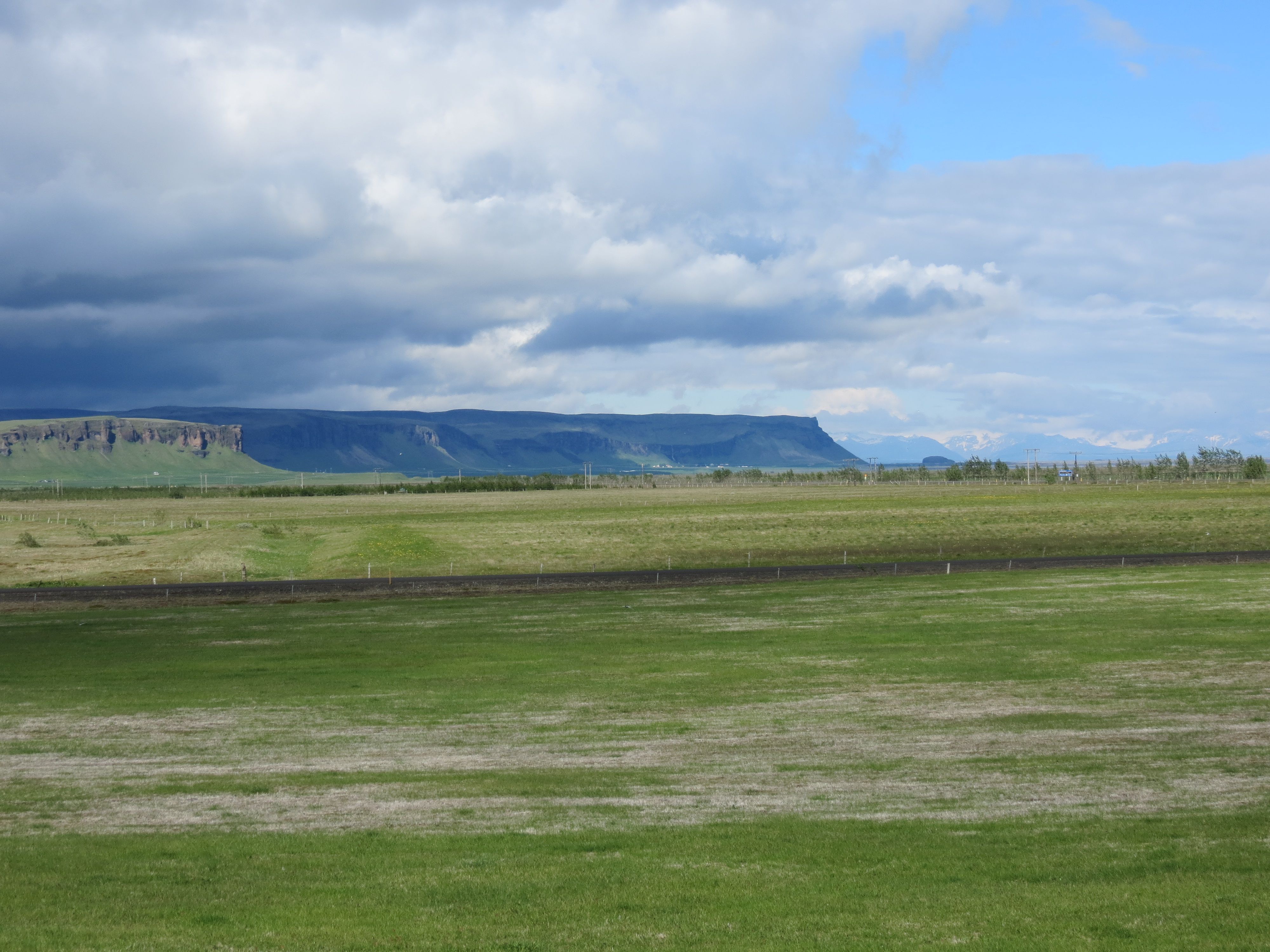
|
–Geoff-Hart.com: Editing, Writing, and Translation —Home —Services —Books —Articles —Resources —Fiction —Contact me —Français |
by Geoff Hart
Today, we took Iceland’s Ring Road east along the bottom edge of the island. The Ring Road is like their interstate: it connects all regions of the country and links the many narrower and lower-quality roads that penetrate the island’s interior. We drove east along the coast to Skaftafell National Park, our final stop, passing through a mixture of the familiar volcanic and glacial landscapes. On this coast, there are many sheer-sided cliffs that rise hundreds of feet from the surrounding plains. The cliffs are sea cliffs, even though they’re currently hundreds of feet or even miles from the sea; they were created by pounding waves ca. 10 thousand years ago, when the glaciers began retreating and the land was much lower in elevation because it was still rebounding upwards after the weight of the glaciers was released. Below the cliffs stretch vast "sandur" areas, which represent the finer sediments washed down from the uplands by rivers roaring outwards from the melting glaciers. These stretch large distances from the cliffs and down to the sea, showing just how much the land has risen and the sea level has fallen. Here’s one such cliff, near the end of our drive to Skaftafell.

Along the way, we caught frequent glimpses of the Vatnajokull ice cap, which is awfully impressive (in the original sense of “awful”, namely “inspring awe). No good photos today, since most of the ice cap was only visible from the bus, and few of the in-bus photos were in focus. The cap stretches from horizon to horizon, and occasional valley glaciers descend from the cap to reach the lowlands. I realize I haven’t defined “ice cap”, so a momentary geological digression: A snow field is what happens when moisture-bearing air rises above a mountain, and the cooling water turns to snow and falls on the slopes. When the snow reaches a depth of 100 feet or thereabouts, the pressure of its weight turns it into ice. The weight of the ice lowers the melting point of the ice at the bottom, which melts, causing the mass of ice to slide slowly downhill towards the lowlands; that sliding ice mass is a glacier. When the glacier only fills a valley between mountains, but leaves the peaks bare, it’s called a valley glacier. When it covers the peaks as well, it’s called an ice cap. The Vatnayökull ice cap is thousands of feet deep in places. Here’s one valley glacier with a landslide (the dark tongue connected to the mountains) running from right to left across the ice:
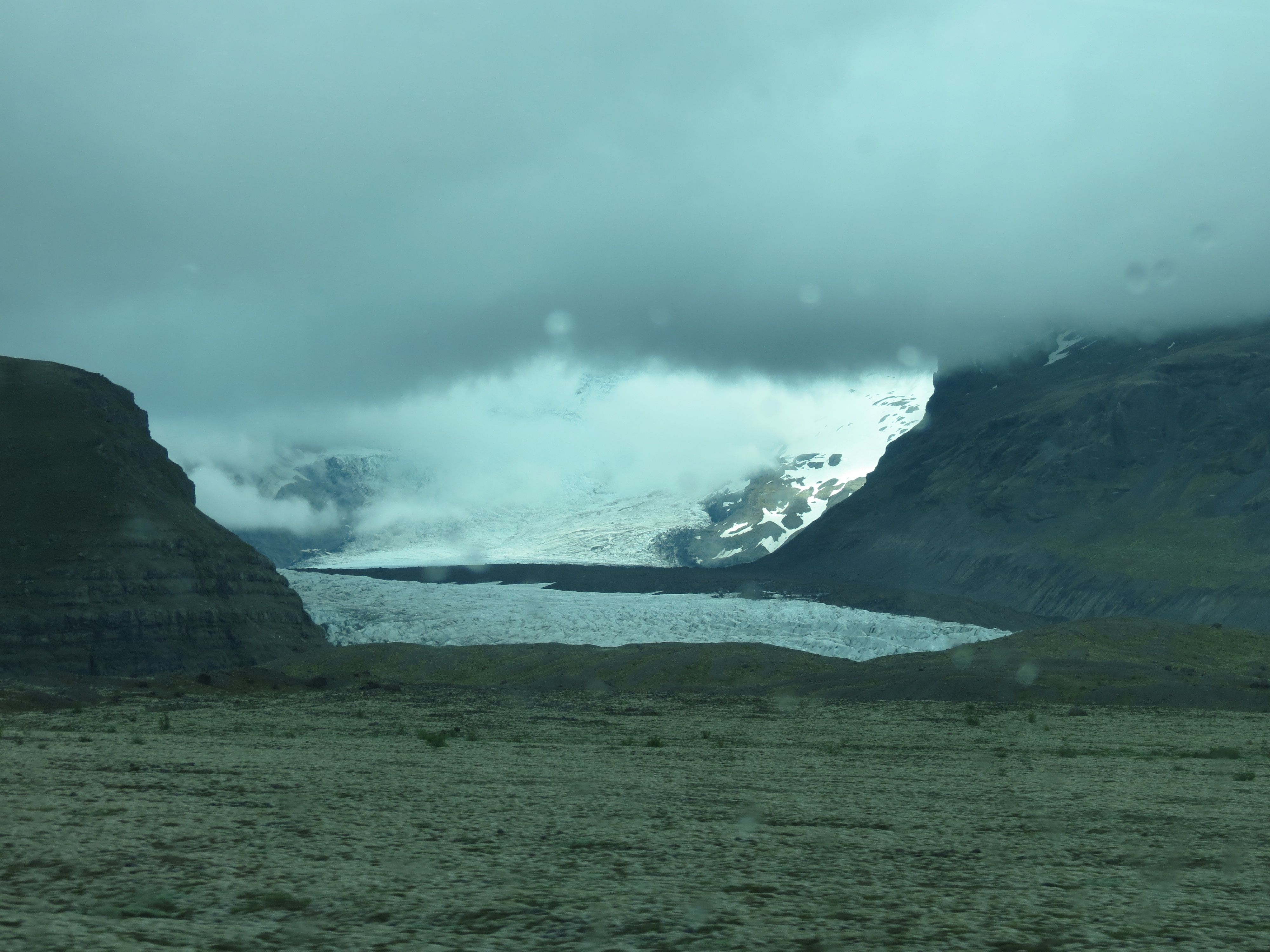
Our first stop along the way was the Skogarfoss (foss = waterfall), which takes more than 500 steps to reach the top. It’s certainly a pleasant site, with roaring snowmelt waters plunging a couple hundred feet, but not nearly as nice as the larger and more complex waterfalls we saw yesterday. Worth a stop, but if you only have time for one stop with plunging water, look for the Gljúfurarbui waterfall group that I described yesterday.
A random etymological note: At the top of Skogarfoss, there was a sign on the far side of a fence that said “no dogs allowed”. The Icelandic word for dogs is “bandi” (with the “d” I typed here being replaced by the Icelandic d with a line through its stem; the “thorn”), which we’d spell phonetically as banthi. Led me to wonder whether Edgar Rice Burroughs knew the word, and chose it for the dog-like banths in his John Carter of Mars series.
Our next stop was the Dyrhólaey nature reserve, which is a lovely stretch of the seacoast: there’s an extensive black sand beach with glassy-smooth wave-polished pebbles, hexagonal basalt columns rising from the sand, wave-carved caves, and Iceland’s version of Canada’s famous Percé Rock. However, here the rock is pierced twice, and the column between the piercings is itself pierced, giving the impression of legs supporting a mighty stone beast. Given that this is Iceland, perhaps a stone giant with its head buried beneath the waves? Here’s a look at the beach-scape and another at the pierced rock:
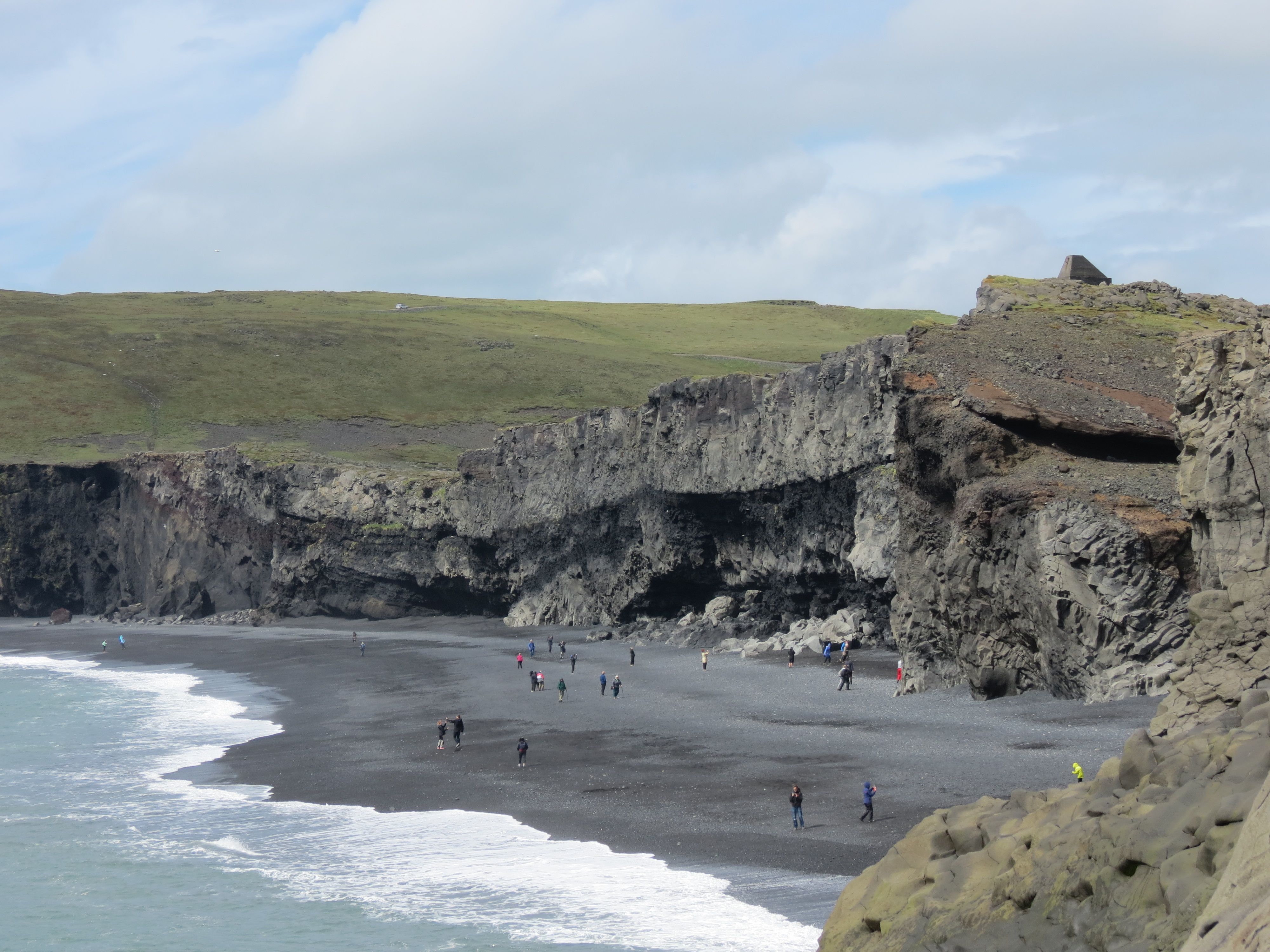
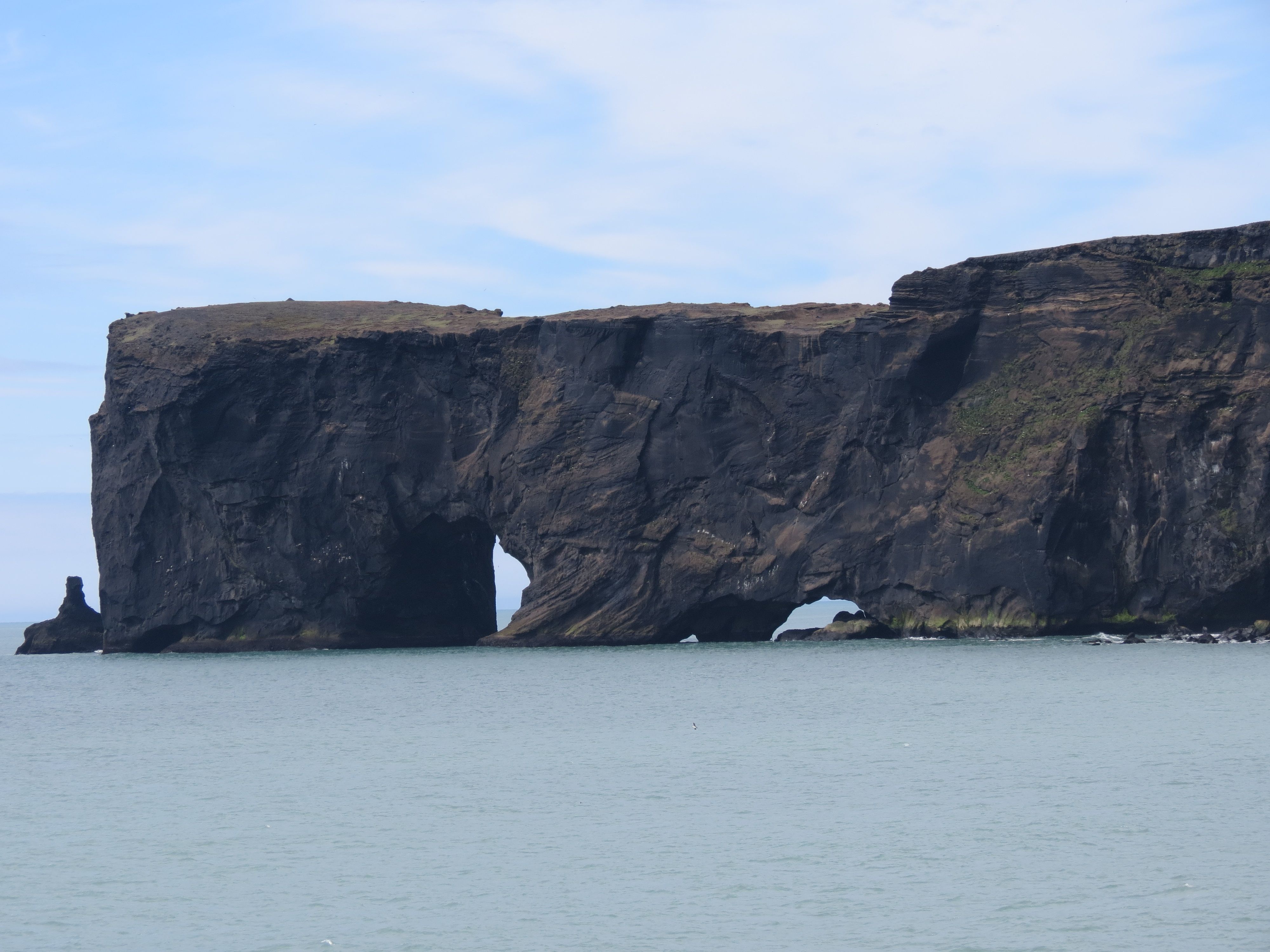
Just as we were leaving, one of the group’s members (Phoebe) reported a small colony of puffins just beyond the parking lot. Since seeing wild puffins was one of the promised attractions of our tour, we all fled the bus to see them in their natural habitat. They’re very charismatic birds. Though I’ve seen them before at Montreal’s Biodome, it’s more special seeing them in the wild. Sarah, one of the group members and an avid birder, described them as “flying potatoes”. It’s so true! Sarah has the birder’s eye: she has learned to see details at distances that leave me thinking “yes, that’s probably a bird”. Amazing what you can see when you know how to observe. Here are a few puffin shots for your birding pleasure:
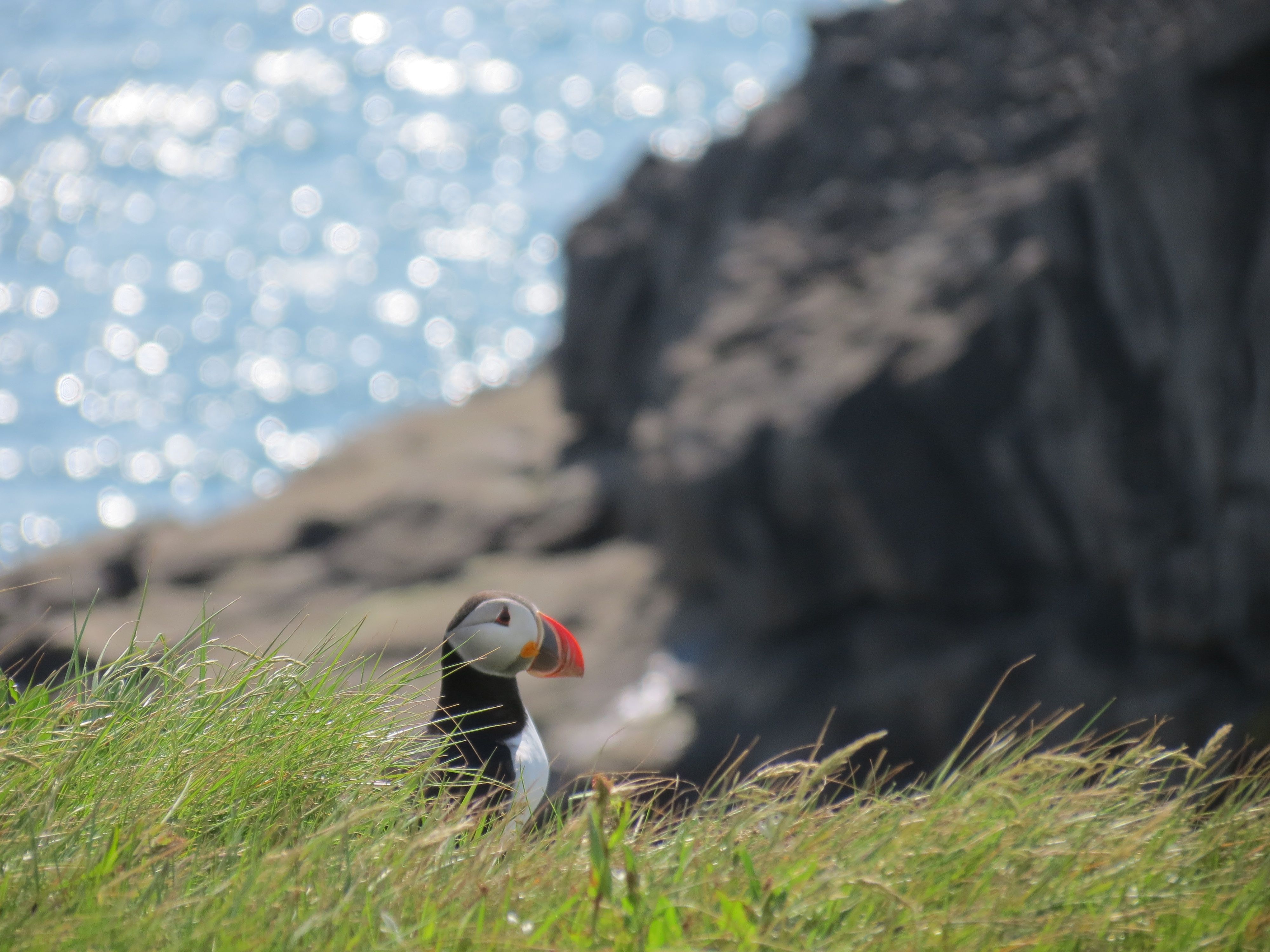
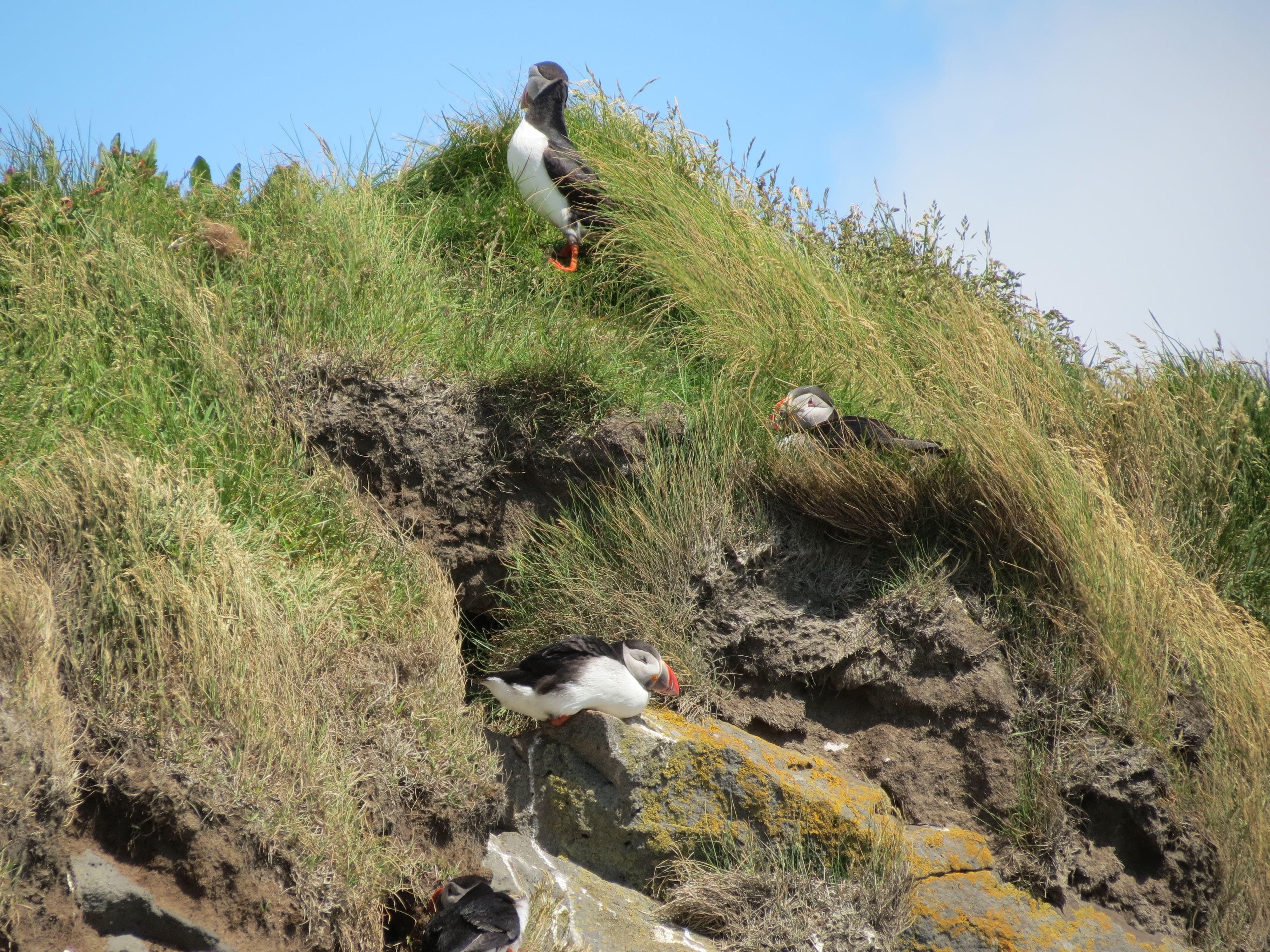
Speaking of birds, a bird update for my mother-in-law Micky, who enjoys birding: In addition to the puffins and previously described birds, we’ve also seen whimbrels, whooping swans, oystercatchers, a northern plover, and what seems to have been a skua pursued by another bird. We also saw a field in which dozens of arctic terns were hovering and then plunging into the short grass. Given how much energy is required for hovering, we’re assuming that they were hunting for some particularly tasty bugs roaming around in the grass. There’s some evidence for this, since one of our group spotted a tern leaving with what appeared to be a worm in its mouth. We don’t think it’s nesting behavior, since they didn’t attack any of our group even when we came within 10 or 20 feet, and we don’t think it’s mating behavior, because the birds weren’t interacting, other than to dodge each other occasionally when another bird veered too close.
Third stop of the day was the coastal town of Vik (pronounced “week”), where there’s a major truck stop and a gift shop that our leader claims has the best prices in southern Iceland. We’ll be stopping there on our way back to Reykjavic, so I didn’t bother with the gift shop. Instead, I grabbed my first Icelandic ice cream (one of those chocolate-coated ice cream on a stick things), and it was yummy. Scarfed it down while wandering towards the black sand beach and enjoying the sight of a dense cloud cap swaddling the headland like an icecap over the interior volcanoes. Not sure what caused this, but given the location, my guess is that when moisture-laden air passes over the ice cap, it condenses to form a cloud that cools, becomes more dense, and flows downhill. When the cloud flows down the mountain slopes and hits warm air rising from the lowlands, the two forces cancel each other out and create a clear separation, like dumping a scoop of potatoes on a glass tabletop. Whatever the cause, it’s certainly unusual. Having read up on Iceland’s often malicious volcanoes, I confess to watching more carefully than might otherwise have been the case to see if the tourists who wandered towards the cloud suddenly dropped to the ground, felled by toxic gases. For the record, they didn’t. Here’s a shot of the cloud:
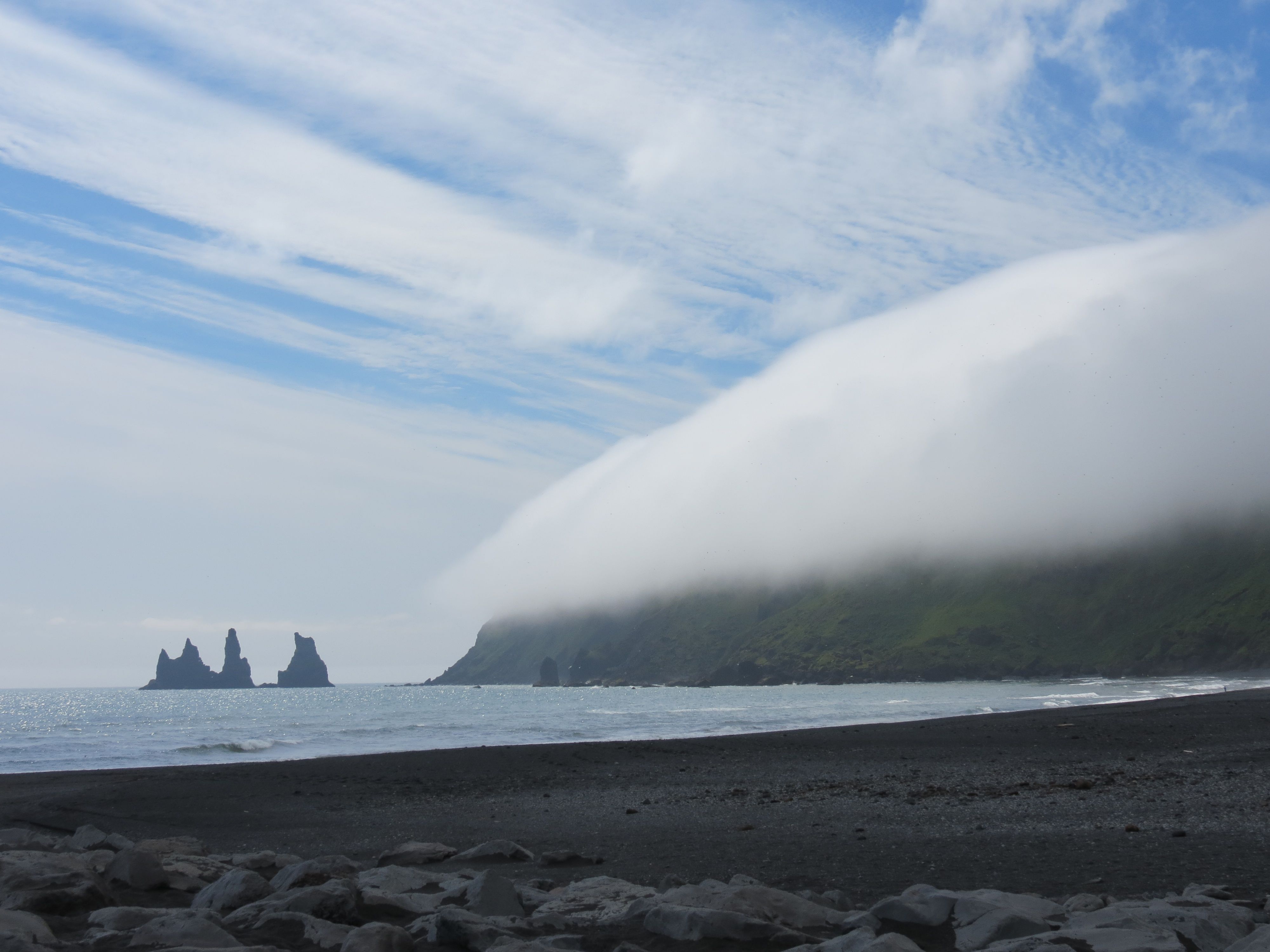
Our itinerary calls for us to stay 3 nights at the Hotel Skaftafell, which is the only game in town. Here, “town” is a somewhat optimistic term, since the town consists of the hotel, another building that may be a newer hotel, and a truck stop across the street. (A note on truck stops: many have an actual grill or even a kitchen, so you can have fare ranging from burgers to a decent meal, depending on the size of the facility.) The hotel's bar, which is one floor up from the restaurant, is the only part of the hotal with a second story, presumably to provide a view of the countryside and of the courtyard between the arms of the C-shape of the hotel. Tim, one of our group members, noted that this resembled a prison. It really does, except, of course, that the open arms of the C that would make for a spectacularly ineffective prison. On the other hand, there’s nowhere you could run to for quite a distance in any direction, so perhaps it would be more effective than I proposed. You be the judge:
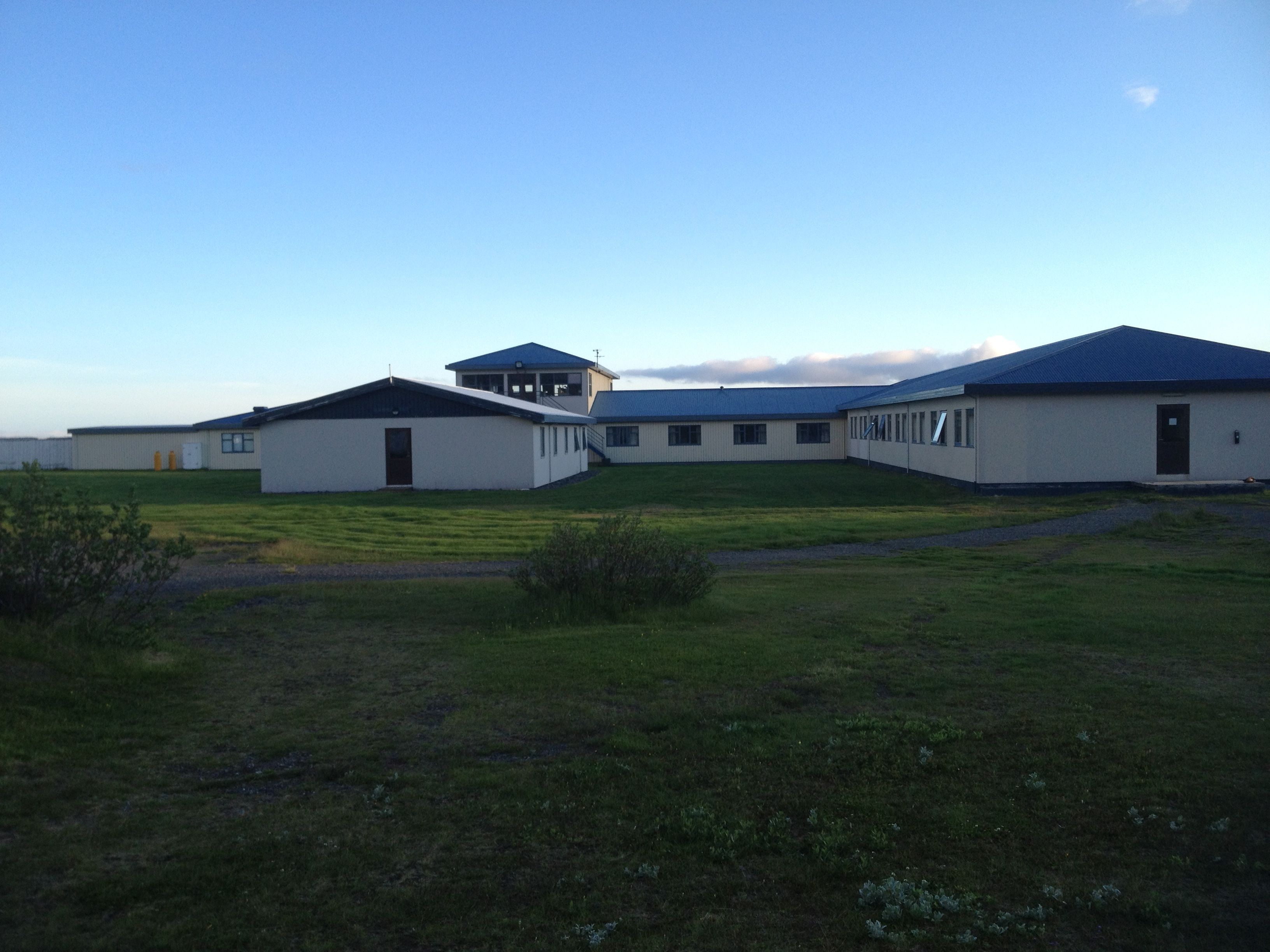
Despite this unfortunate impression, it’s a quiet and pleasant place; the room décor is more Motel 6 than Ikea, but it’s clean and comfortable and quiet. Best of all, and why Dick chose it as our base, it’s close to two valley glaciers that descend nearly to the lowlands. I decided to go out for a pre-bed walk, and was amply rewarded. From the slope behind the hotel, you can see a lovely snowcapped mountain with sharp ridges and a tall glacier resting on its shoulder; it’s the archetypal mountain, and the sunlight made the view spectacular. A little further up the slope, you can see a wide valley glacier. Despite this nominally being the rainiest part of Iceland, the clouds remained resolutely ornamental rather than pluvial; we’ve been having God’s own luck with the weather. The result was stunning:
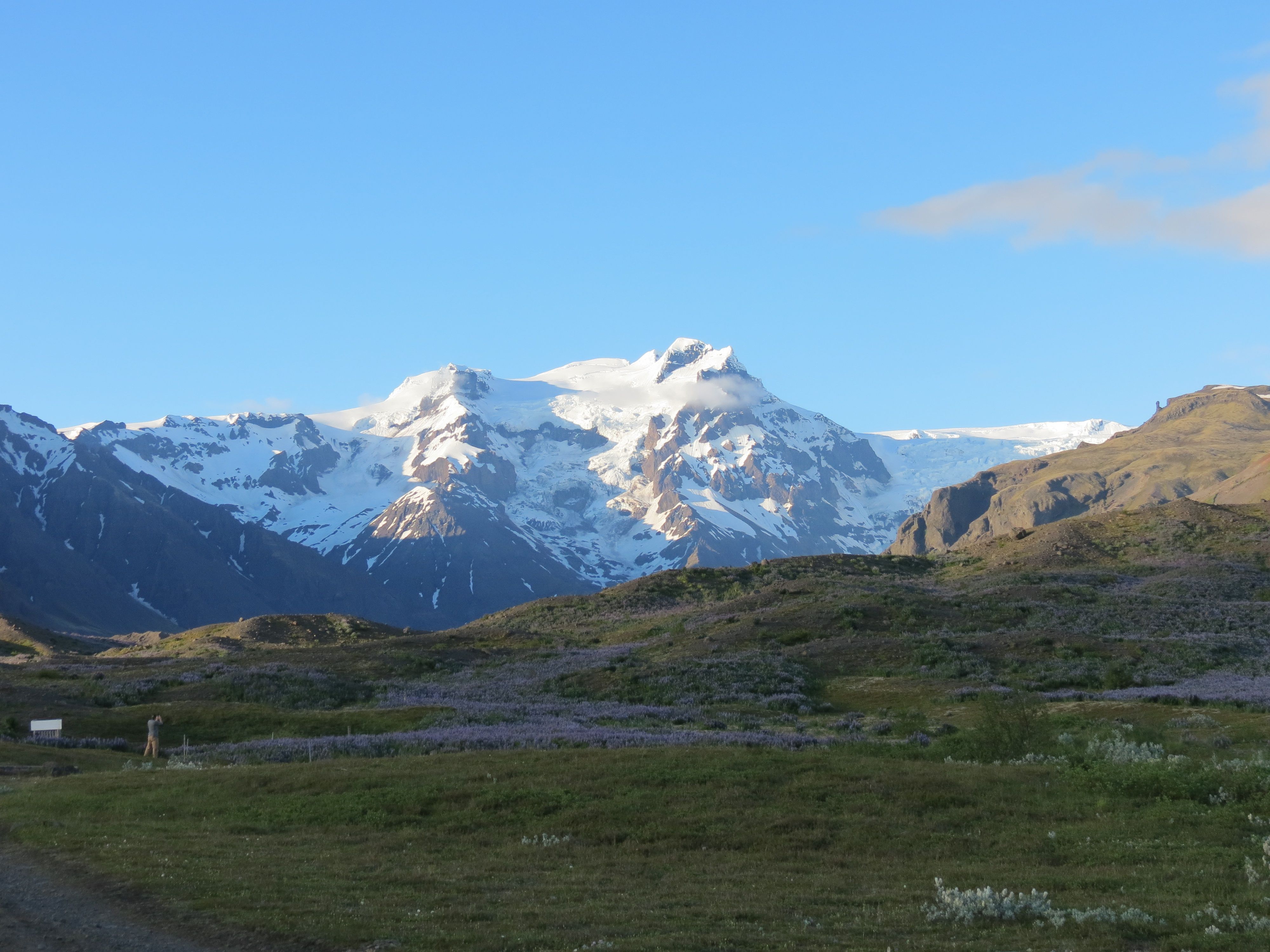
In contrast, the larger valley glacier to the west of us lay partially in the shadow of the flanking mountains, so it had a bit of a blueish hazy tinge. It was also much dirtier, with many swirls of ash covering its surface. The two make for a fascinating contrast. We will be visiting the valley glacier tomorrow. Here’s a sample:
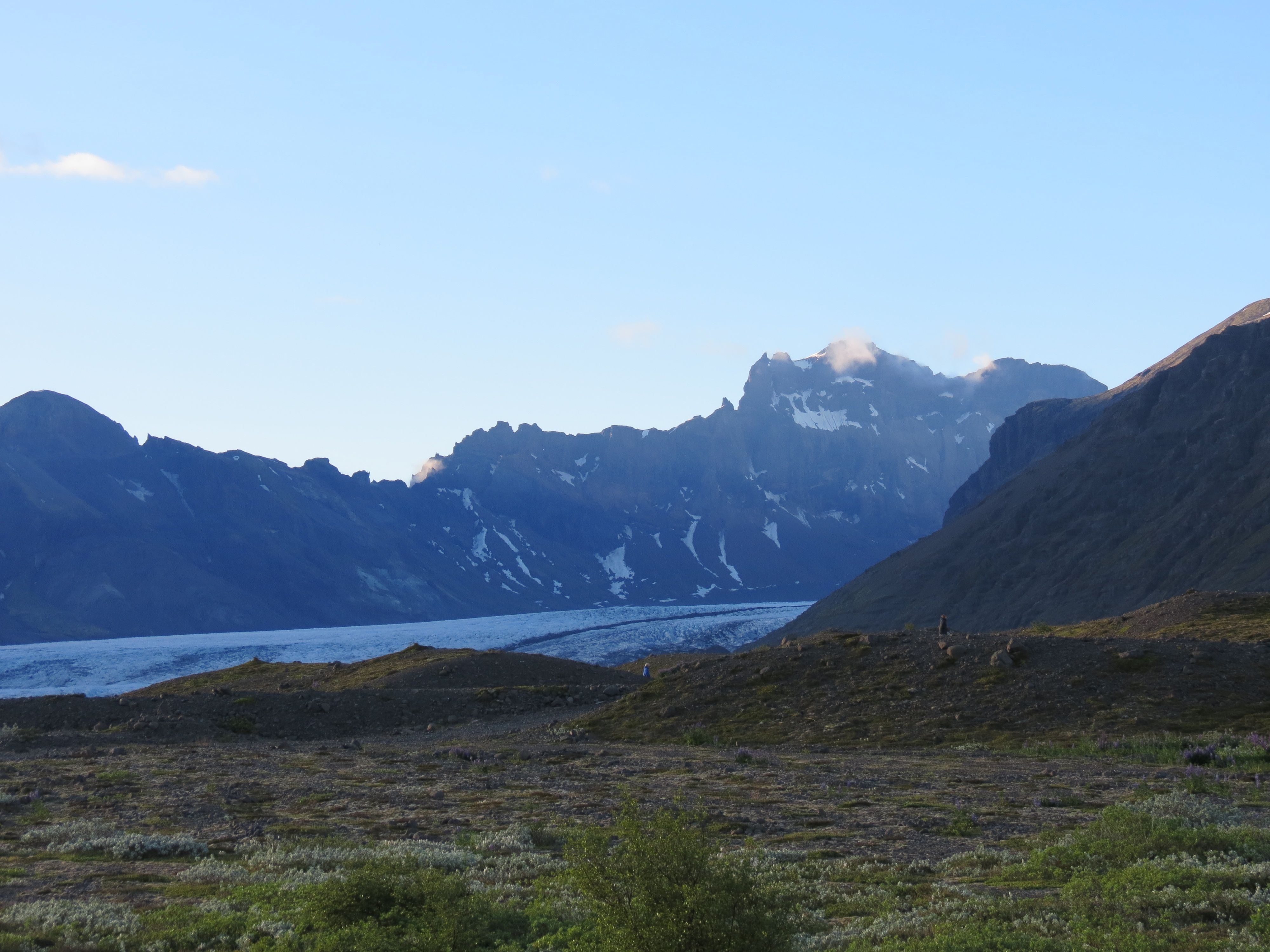
Shoshanna had been too tired to come along, but I rousted out of bed to see the play of light on the two very different glaciers, and she appreciated the view. While she dressed, I ran across the Ring Road to the local gas station cum 7/11 so I could get some of the local Vatnayökull-brand beer, which was delicious: it’s made from water obtained from icebergs that calved from the glacier we’ll be seeing tomorrow (suitably filtered, one hopes, to remove silt and microorganisms), and it’s brewed with a hint of the arctic thyme that grows wild in the fields. The result is a sweetish porter-style beer with a really interesting and subtle thyme taste. It’s slightly too sweet, but with a little less sugar, it would be truly exceptional.
Next installment: July 4: "Iceberg Day"©2004–2024 Geoffrey Hart. All rights reserved.